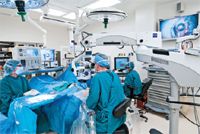Article
Kellogg Eye Center lifts roof on vision
The newly expanded $132 million Kellogg Eye Center at the University of Michigan, Ann Arbor, boasts 230,000 square feet of clinical and research space across eight floors that house clinics, six operating rooms, research space, and faculty offices.
Ann Arbor, MI-The newly expanded $132 million Kellogg Eye Center at the University of Michigan, Ann Arbor, boasts 230,000 square feet of clinical and research space across eight floors that house clinics, six operating rooms, research space, and faculty offices. The building, dubbed the Brehm Tower at the W.K. Kellogg Eye Center Complex, increases the eye center's size by 50%.

"The building is only a physical plant," Dr. Lichter said, "but it does help attract the best people and helps to initiate and continue the best programs and the best staff, residents, and fellows."

Dr. Lichter said the diabetes research center is greatly enhanced by the addition of ophthalmologist Thomas W. Gardner, MD, MS, and basic scientists David A. Antonetti, PhD, Steven F. Abcouwer, PhD, Cheng-Mao Lin, PhD, and Patrice Fort, PhD, who will continue their study of diabetic retinopathy alongside diabetes researchers.
It took more than 2 years to recruit this team to the University of Michigan, which has established itself as an important center for diabetes research.

The school plans to capitalize on the strengths of the University of Michigan Medical School by integrating new ophthalmology faculty to work alongside established laboratories. Newly recruited faculty Raymond S. Douglas, MD, PhD, an oculoplastics specialist, and Terry J. Smith, MD, an endocrinologist, are testing candidate drugs for the treatment of Graves' disease, which has been a focus of study at the university. Drawing on resources within the eye center and university, the pair hopes to establish an international center at Kellogg for the comprehensive research and treatment of Graves' disease.
In the same way, Hakan Demirci, MD, will develop a formal ocular oncology department within the department to augment the university's major cancer center.
"This will expand it greatly and make it more of a destination program," Dr. Lichter said.
Meanwhile, researchers continue to test a metabolic imaging optical instrument that uses the eye's autofluorescence to screen for subtle changes in the retina that could indicate diseases before they are otherwise detectable. Developed by Victor M. Elner, MD, PhD, and Howard R. Petty, PhD, this noninvasive test also could show the effects of a drug given to treat disease, Dr. Lichter said.
Newsletter
Don’t miss out—get Ophthalmology Times updates on the latest clinical advancements and expert interviews, straight to your inbox.





